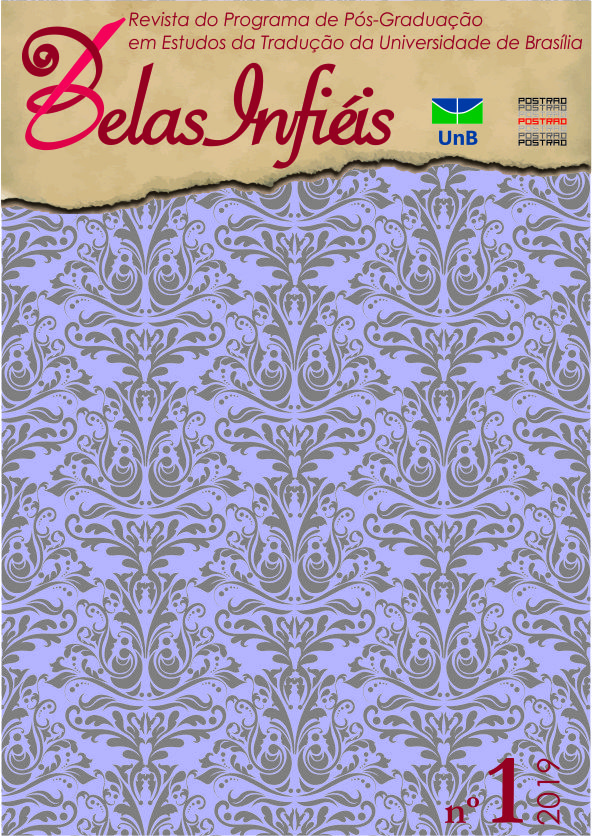O corpo de disciplinas de tradução na formação de tradutores e intérpretes de língua de sinais no Brasil
conteúdos, carga horária e competências.
DOI :
https://doi.org/10.26512/belasinfieis.v8.n1.2019.12775Mots-clés :
Formação, Competências, Tradução, Língua de Sinais, Desenho CurricularRésumé
Considerando os cursos de graduação destinados à formação de tradutores e intérpretes de Libras-Português nas universidades federais brasileiras, realizamos uma análise das disciplinas direcionadas ao desenvolvimento de conhecimentos, habilidades e atitudes especificamente relacionados à tradução e à interpretação. Para tanto, com base nos nomes e nas ementas das disciplinas, em suas cargas horárias e nas informações contidas nos projetos políticos pedagógicos dos cursos, categorizamos cada disciplina de acordo com o tipo de conhecimento a ser abordado (conceitual, procedimental e/ou atitudinal) e com o conteúdo proposto (conhecimentos teóricos, práticas, tecnologias aplicadas, ferramentas de pesquisa e/ou aspectos profissionais). Vimos que os cursos, de maneira geral, possuem diversos elementos que os aproximam, assim como ênfases específicas que os distinguem. Concluímos que o desenho curricular dos cursos de formação de tradutores e intérpretes generalistas de Libras-Português precisa, não somente estar bem fundamentado em princípios pedagógicos e tradutológicos, mas, inclusive, estruturar-se com base no perfil do profissional que se pretender formar e nas demandas atuais do mercado de trabalho. Além disso, a questão da modalidade gestual-visual, com seus efeitos e não efeitos sobre a tradução e a interpretação, deve ser encarada como uma temática transversal, indispensável à formação dos tradutores e dos intérpretes que atuam entre línguas e modalidades.
Téléchargements
Téléchargements
Publié-e
Comment citer
Numéro
Rubrique
Licence
Copyright Statement
Given the public access to this journal, the texts are free to use but requires the recognition of the original authorship and initial publication in this journal to be properly stated.
The journal allows the use of works published for non-commercial purposes, including the right to submit the work to publicly accessible databases. Published contributions are the sole and exclusive responsibility of the author(s).
- When submitting papers to be evaluated by the Belas Infiéis journal, the author(s):
- Declare that the contents of the contributions are original and of their original creation, being entirely responsible for their content if there is an objection by third parties.
- Claim to be aware that they should not commit academic plagiarism.
- Declare that the manuscript has not been published, completely or partially, in Portuguese or another language. If it is a translation it should be submitted to the Translated Articles section.
- Declare that the manuscript is not being evaluated by other journals.
- Declare that the manuscript was not submitted to another journal simultaneously.
- Commit(s) to inform the journal of any kind of error or inaccuracy in their contribution (published, in evaluation or in editing) and to collaborate with the editors to make due corrections of the article (when in evaluation or editing) or erratum/retraction (after publication).
- Declare that there is no conflict of interest regarding the published work.
- Authorize its release if it is accepted for publication without any kind of monetary compensation.
- Agree to assign non-exclusive rights to publication to the magazine, remaining free to make their contribution available in other media as long as the publication of the first version in Belas Infiéis magazine is mentioned. They also authorize Belas Infiéis to assign their texts for reproduction in content indexers, virtual libraries and similar platforms.
- Maintain copyright and grant the journal the right of first publication, the work being licensed under theCreative Commons Attribution License.
- Is/Are allowed and encouraged to publish and distribute their work online after the editorial process, which may increase the impact and citation of the published work.
- Authorize the editorial team to make textual adjustments and to adapt the article to the publication rules, when necessary.



















